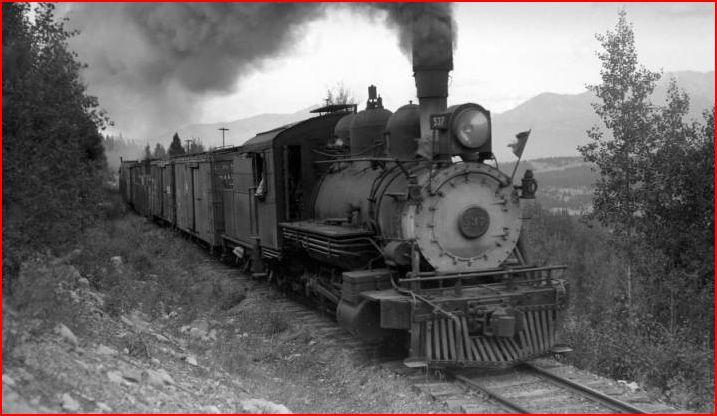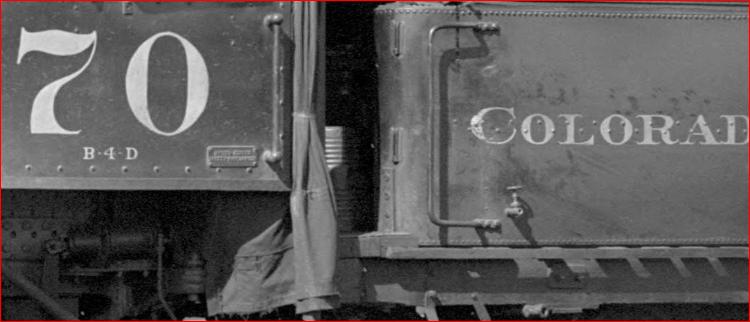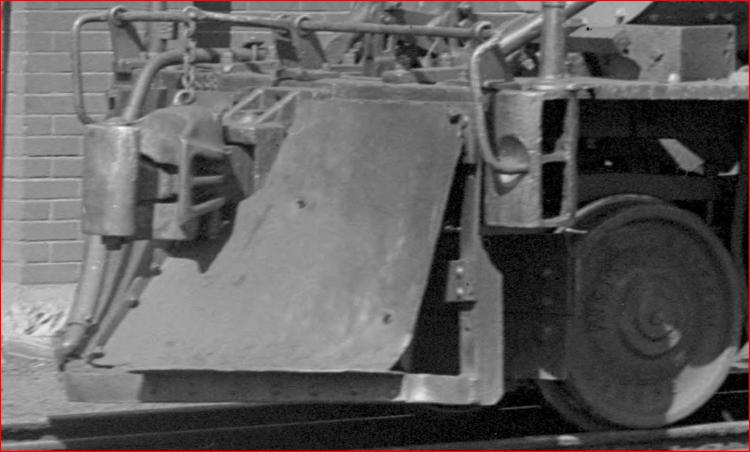Love me tender (With apologies to Elvis) …
123456













123456
Re: Love me tender (With apologies to Elvis) …
|
Has anyone noticed that the coal retaining board brackets normally facing each other inside the water wings were positioned facing away from each other outside of the water wings on the oil tender? You can see that OMI reproduced this in the photo of the model.
|
Re: Love me tender (With apologies to Elvis) …
|
In reply to this post by Derrell Poole
One more diatribe from rantty ol' Derrell;
A couple of people have mentioned the question of motive power on the C&S and how they never really upgraded. There are some very good, tho maybe not so obvious, circumstances why that never really happened. At the TOC the Standard Gauge was - as it always would be - the focus of the C&S. As much as we love the ng it was always a stepchild to the "real" railroad. I have every confidence the company fully intended to exploit the ng from the beginning but the sg was the immediate money maker and money sponge. The promise of upgrading the ng was probably; that much of it was slated to be broadened anyway (or abandoned) - so no real money was sunk into new locomotives. That plan, to broaden, was pretty much shot down with the loss of the South Fork of the South Platte to the Denver Water Board in 1902. Now, you won't find this in so many words in the C&S records so I'm sure we can haggle over this in detail - not interested. This is forensics and nobody is going to prove anything other than the circumstances support the notion. With the loss of the Nighthawk extension the fire went out of the Transcontinental idea (which could have used both the jointly owned CM as well as the partnership with the Rio Grande Western to attain the west coast). Eventually the RR went to the CB&Q and the true disdain for the ng became abundantly clear almost immediately. Only the public outcry and the PUC stopped abandonment in the early teens. The truth is that the line itself was incapable of handling larger engines (with a chance to approach economical viability) without huge and unjustifiable amounts of cash invested in upgrading the physical property. Objectively we cannot blame the C&S and the Q for trying their best to dump this money pit. In short they could not use bigger engines even if they had received them as gifts. True, the big Fs and the Q engine were pretty heavy but note how they never ventured off the mainline to Leadville. Ever see 537 in Clear Creek Canyon? I haven't... |
Re: Love me tender (With apologies to Elvis) …
|
This post was updated on .
In reply to this post by Derrell Poole
CONTENTS DELETED
The author has deleted this message.
|
Re: Love me tender (With apologies to Elvis) …
|
CONTENTS DELETED
The author has deleted this message.
|
Re: Love me tender (With apologies to Elvis) …
|
In reply to this post by John Schapekahm
Why John, you simply need to look at the photos. The giveaway is the funky grab at the cab deck. Full disclosure: I only noticed this a couple months ago comparing photos in the RRobb book. What first caught my eye was the cast trucks, then the grab.
There we other C&S locos that also traded tenders too. Mr. Poole knows those suspects. If you really want to start a fight, you can speculate on the D&RG tender trades, but we South Parkers are a more polite bunch.
Keith Hayes
Leadville in Sn3 |
Re: Love me tender (With apologies to Elvis) …
|
In reply to this post by Derrell Poole
According to Poor's Memorial, Case was between Kenosha Pass and Jefferson.The photo,which is in the Pictorial looks like it was taken slightly north of Garos on the Alma branch.I have read accounts of trains going as far as Cohen Spur to pick up cattle shipments as late as the scrapping-could they have made it to Bath?Cohen Spur is very close, but not right on, the townsite of Weston.I believe there are two C&S era photos take near there-Pictorial p368(caption says Platte River),and the other is in MB2,which I no longer have.Pictorial p433 shows photos of the scrapping.Were any more photos taken of that operation?
|
|
In reply to this post by Derrell Poole
Derrell, methinks the hand grabs on the engine deck do not extend far enough from the tank on the model. In the photos these almost look like guardrails.
They did pick up on the washer on the end of the oil tank, though. Interesting that the C&S did not favor tender headlights, evidently preferring to wye locomotives in lieu of running great distances in reverse (the exception being the short reverse move between the Como wye and depot). Interesting that the west end boys liked 70. I have not seen photos of 537 west if Como, but never say never.
Keith Hayes
Leadville in Sn3 |
Re: Love me tender (With apologies to Elvis) …
|
In reply to this post by Robert McFarland
I stand corrected. Very good, Robert - it is indeed Cohen Spur I was speaking of. Case was at the bottom of Kenosha Hill west side.
There was also what appears to be a wye near Cohen if you follow Google maps of the line. Probably put in after the line was taken up south of there. This would post-date the ICC survey. |
|
In reply to this post by Keith Hayes
Could be Keith. I'm sure John's astute eye will detect the necessary variants to correct his model from the Sn3 version.
The only place you saw backup lights on C&Sng engines - typically - was on switchers. There must have been some logic for the lamp on the oil tender - notice how high it was placed. Wonder why? |
|
Administrator
|
In reply to this post by Keith Hayes
Hi Keith.
Yes, #537 spent a lot of time on the West End. In reading of the 1936 wreck on Boreas with the #73 and #75, the train was actually listed as "Extra #537", as it was the Road Engine following the train. This validates our conversation of a couple weeks ago about how the trains were identified. Additionaly, there is a photo of #537 on the head end of Train No. 71 at Leadville on April 6, 1937. This stuff and much more is in Hol Wagner's Burlington Bulletin No. 41" which is discussed in this thread. As to the front tender grabirons on both #70 and #537, they were indeed extended forward for safety. |
Re: Love me tender (With apologies to Elvis) …
|
Administrator
|
In reply to this post by Derrell Poole
I believe what you are referring to were actually weather shields to try to keep wind and rain and snow more managable than without them.There wouldn't have been a fireman out there much on #70, still, it's interesting that they were there, and apparently welded to the oil bunker.
|
|
In reply to this post by Derrell Poole
CONTENTS DELETED
The author has deleted this message.
|
|
CONTENTS DELETED
The author has deleted this message.
|
Re: Love me tender (With apologies to Elvis) …
|
In reply to this post by Mike Trent
Wow, this thread is awesome. I now know I am not alone in agonising over Locomotive details that are obtuse, regardless of the type and scale. {:))
#537 Eastbound out of Leadville all by herself and late in the days. http://digital.denverlibrary.org/cdm/singleitem/collection/p15330coll22/id/45812/rec/1  That brass model oil tender seems to me to have the front waterleg tank stays outward rather than inline with the frame, that's about the only nit I could pick. (so far) {:)) Also note the galvanized can for the flue sand. http://digital.denverlibrary.org/cdm/fullbrowser/collection/p15330coll22/id/42299/rv/singleitem/rec/78  Are you brave enough to go for that funky sheetsteel snowplow?  There are several John Maxwell colour photos of the #70 west of Denver in Min. Belt 1, just to refresh your memories. Wonderful photos! EDIT: Sorry Mike, this is not in reply to your post, I don't know how that happened {:(
UpSideDownC
in New Zealand |
Re: Love me tender (With apologies to Elvis) …
|
In reply to this post by Derrell Poole
I believe that wye was for Weston.
|
|
This post was updated on .
In reply to this post by John Schapekahm
John, ya just never knew when you were geting home when in Engine service. There were many times I started out in daylight on a job that was always home in daylight (OK summer months) and didn't. My first day on the job was the 0700 shunt, ended up on a road job South at 1230, returned home well after dark around 2100.
>>[Aside] Just out of curiosity, any thoughts on why that oil intake is so doggone tall ?!? Could this be because the Oil facilities at Denver were not intended for N.G. but the dreaded S.G. and therefore would be set much higher to accomodate the larger height?
UpSideDownC
in New Zealand |
Re: Love me tender (With apologies to Elvis) …
|
In reply to this post by Chris Walker
CONTENTS DELETED
The author has deleted this message.
|
|
Then I shouldn't show this beauty then?
http://digital.denverlibrary.org/cdm/fullbrowser/collection/p15330coll22/id/42584/rv/singleitem/rec/161  How far can #70 go on that tank of Oil? I'm only guessing that this a Como run. I can't see that if #70 couldn't make Como, why she would be the road loco? Things to ponder eh!
UpSideDownC
in New Zealand |
Re: Love me tender (With apologies to Elvis) …
|
In reply to this post by Derrell Poole
I will take the contrarian position Derrell. I believe that the true end of the 3' gauges importance AND the transcontinental connections ended in 1909 with the C&S being purchased by the CB&Q.
Why? First was the replacement of Frank Trumbull, who followed Edwin Hawley and became the President of the C&O, Second was because the CB&Q hated any gauge other than 4' 8 1/2" as evidenced by their rush to rid themselves or regauge all of the 3' lines in Minnesota and later in the Black Hills. Add to that the famous letters and notes from Chicago to Denver complaining about the lack of repainting the 3' gauge equipment with the Burlington Route box trademark. Robert Rice's reply about the lines being abandoned soon and not wanting them to be associated with the Q speaks volumes. The transcontinental connections would have ended with Trumbull leaving and the Chicago takeover because the CB&Q's owners, the NP and GN all ready made it to the west coast. Why put money into a redundant route? I still believe that after the Cheesman Dam collapsed that the C&S could have gone back and gotten the Right of Way from South Platte to Florissant or Hartsel, wherever the connection was supposed to be by the fact that the water company who influenced the Judge to rule in their favor was pretty effectively done. (No, It wasn't the Denver Water Board at that time). But Trumbull was no longer there, the 1/2 ownership in the Midland was gone. In my opinion (for what it's worth) the C&S would have been a much more powerful force in the National Railroad scene had the sale to the CB&Q never had taken place. After all, the C&S was, until it's final merger into the BN, the smallest Class I railroad in the US. Rick |
Re: Love me tender (With apologies to Elvis) …
|
In reply to this post by Chris Walker
Chris,
I would not take that galvanized can for flue sand. Flue sand was usually kept in a box that was fabricated of steel an integral part of the tender. My interpretation of the Galvanized can would be for drinking water. There were agreements that provided for drinking water on locomotives, as the tender water was treated and drinking it would put a trainman out of commission for a couple of days while his digestive system righted itself. Rick |
«
Return to C&Sng Discussion Forum
|
1 view|%1 views
| Free forum by Nabble | Edit this page |

